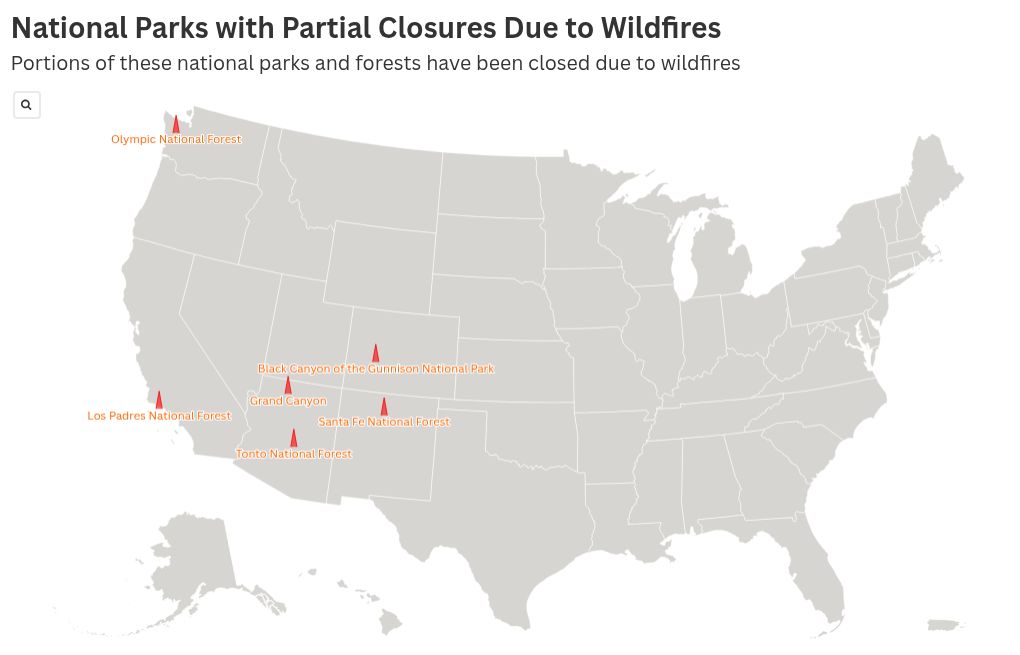Dozens of wildfires are burning across the United States, with several threatening national parks and forests and forcing partial closures and restricted access to popular natural landmarks.
Newsweek has reached out to the National Park Service (NPS) and the U.S. Forest Service for comment via email on Sunday morning.
Why It Matters
There have been hundreds of fires across the U.S. this year, with over 3,290,000 acres burned, according to the National Interagency Fire Center.
Wildfires endanger lives not only through the immediate threat of flames that scorch homes, roads, and infrastructure, but also through lingering hazards like smoke and fine particulate matter PM2.5, which can severely degrade air quality and pose health risks.
National parks and forests are major summer destinations for tourists, making it essential for visitors to stay informed about ongoing wildfires to ensure their safety.
What To Know
Several notable blazes, such as the Dragon Bravo fire have shuttered portions of well-known national parks including the Grand Canyon. A lightning strike ignited the fire in the park’s North Rim on July 4. In the weeks since, the fire has destroyed nearby structures, including the historic Grand Canyon Lodge.
The fire prompted NPS officials to close the North Rim entrance for the season. There is a slew of closed trails listed on the park’s website. There are currently around 1,200 personnel dedicated to the fire. As of Sunday, it has burned over 114,000 acres.
A more recent blaze, the Gifford fire which broke out in California on Friday, has led to evacuations in San Luis Obispo and Santa Barbara counties. The fire has grown into the state’s second-biggest this year behind the Madre fire, which also burned in San Luis Obispo County.
The Gifford fire is only 5 percent contained, as of Sunday morning, having burned nearly 40,000 acres. The cause of the fire is still under investigation, and over 561 personnel are working to contain the fire.
Earlier in July, the South Rim fire in Colorado, which is unaffiliated with the fire in the Grand Canyon, was ignited by lightning strikes and has closed the South Rim part of the Black Canyon of the Gunnison National Park. The North Rim portion of the park recently reopened.
As of Sunday, the fire is 52 percent contained, with an estimated containment date of August 10. The fire has burned over 4,000 acres.

The Billy fire, also caused by lightning, located in the Tonto National Forest has led to closures of parts of the forest as nearly 2,500 acres have been scorched. The fire is currently 65 percent contained.
Further north, the Bear Gulch fire has closed parts of the Olympic National Park, including some trials and picnic areas, until October. The fire was started by an individual on July 6 and has burned over 4,700 acres.
The Laguna fire, which has burned over 17,000 acres, has closed portions of the Santa Fe National Forest since July 18.
There have been several other fires that have closed portions of national parks and forests this summer, including the Rush fire in the Payette National Forest, however the trail closure order was terminated on August 2.
What People Are Saying
Grand Canyon National Park Service wrote in an X post on Saturday: “Good morning from Grand Canyon National Park on Saturday August 2, 2025. The Extreme Heat Warning has now been extended through Tuesday, August 5, at 7 pm. The North Rim of the park is closed because of damage and losses caused by the Dragon Bravo wildfire.”
California Governor Gavin Newsom’s official press office X account posted Saturday: “The #GiffordFire started on Trump’s federally managed land in the Los Padres NATIONAL Forest. While Trump just gutted wildfire funding, @CAL_FIRE is now stepping in to clean up what federal mismanagement helped fuel. That’s the California way.”
Representative Jeff Hurd, a Colorado Republican, wrote in an X post on July 28: “This morning, I visited the South Rim Fire with Stuart West, the Superintendent of Black Canyon of the Gunnison National Park. It was an honor to meet with emergency responders to see the response firsthand. Federal, state, and local crews in #CO03 are working in close coordination to protect lives and land. These folks are doing heroic work, and I’m making sure they get the support and resources they need, now and in the future.”
What Happens Next?
Thousands of fire crews are battling wildfires across the nation, while national parks work to assess damage, conduct safety inspections, and carry out maintenance before reopening closed sections to the public.
A community meeting for the Dragon Bravo fire will be held in Fredonia, Arizona, on August 5.
The post Map Shows National Parks Where Wildfires Have Prompted Partial Closures appeared first on Newsweek.




